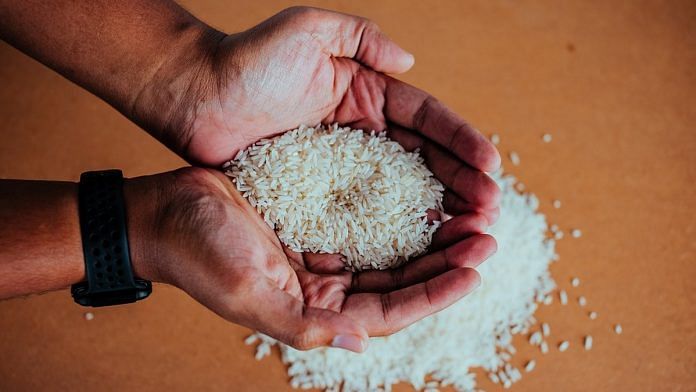New Delhi: To battle the prevalence of anaemia in India, the Narendra Modi government has started the process of making fortification of rice mandatory in the country.
Fortification refers to a process of increasing the content of an essential micronutrient, such as vitamins or minerals, in a food item to improve its nutritional value and provide public health benefits at minimal cost.
The Food Safety and Standards Authority of India (FSSAI) — the country’s apex food regulator under the Ministry of Health and Family Welfare — is working on a proposal to make fortification mandatory for rice in the next three years. This will cost the exchequer an estimated Rs 2,500 crore every fiscal year.
According to the authority’s estimates, rice is the staple food of more than 70 per cent of the Indian population. Therefore, in an effort to increase the nutritional value of the food consumed and reduce the incidence of anaemia in the country, the central government is planning to fortify rice with iron, folic acid and vitamin B-12.
Anaemia is a condition in which a person has low levels of red blood cells or concentration haemoglobin, which reduces the capacity of their blood to carry oxygen. The most common causes of anaemia are nutritional deficiencies, particularly iron deficiency.
“We have started working on the plan and inter-ministerial discussions are going on. We have estimated that the cost of fortified rice will go up by 60-70 paise per kg. In total, the cost incurred by the government will be Rs 2,500 crore per fiscal year for distributing fortified rice through the mid-day meal schemes and through the Public Distribution System (PDS), as per internal estimates,” a senior official from the FSSAI told ThePrint.
He added: “The fortification process is a viable proposition as it is likely to reduce the incidence of anaemia in India by almost 35 per cent in a few years of launching the scheme.”
“Anaemia leads to the economic loss to the nation due to lesser productivity of the population. Furthermore, it will reduce the problem of low birth rate and compromised mental development,” the official said.
According to the National Family Health Survey 2015-16, 58.6 per cent of children aged between 6-59 months and 53.1 per cent of all women surveyed aged between 15-49 years were anaemic.
Furthermore, half of the pregnant women surveyed in the NFHS aged between the ages of 15 and 49 were also found to be anaemic, along with 23 per cent of men aged 15 to 49 years.
Also read: 5 reasons why Vitamin K needs to be explored as a hedge against Covid-19
Modi endorses fortification of grains
The central government’s plans to make fortification of rice mandatory aligns with Prime Minister Modi’s endorsement of fortified food to address micronutrient deficiency, during his address on World Food Day Thursday.
In his address, Modi had noted that “common varieties of some crops lack key micronutrients that are essential for good health, and thus biofortified varieties were developed to overcome these shortcomings.”
In 2019, Modi government had also approved the Centrally Sponsored Pilot Scheme on ‘Fortification of Rice and its Distribution under Public Distribution System’ which was approved for a period of three years beginning 2019-20 and focuses on 15 districts.
The World Health Organization also recommends fortification of rice with iron, vitamins and folic acid as a public health strategy to improve the iron levels of populations, in settings where rice is a staple food.
FSSAI has been pushing for fortification since 2018 when they launched a new ‘+F’ label for fortified foods and had set standards for fortification in five categories of staples including wheat flour, rice, milk and edible oil and double fortified salt. However, the norms are not mandatory to follow.
Also read: India starts cultivating hing, a staple ingredient that costs $130 mn each year to import
How will fortification be done?
According to the government’s plan, rice will be extruded and then shaped into structures that resemble rice grains. The process of extrusion involves reforming rice flour into a precooked product that can be shaped to resemble a rice grain.
These kernels will then be fortified with micronutrients such as iron, folic acid and vitamin B-12 as planned and mixed with natural polished rice.
The process is carried out by rice millers, who will need to upgrade their manufacturing sites by installing machines to produce fortified kernels.
“We are discussing the plan with the Ministry of Food Processing Industries. The final plan will be discussed with industry stakeholders in the later stages,” said the official quoted above.
Also read: Govt shoots off letters to doctors, seeks answer on seminars ‘sponsored’ by baby-food makers




Now this country is going fully in control of bill gates & illuminati. Now destroying natural nutrients in food.
Good to know people are aware, many are ignorant. Food fortification never helps, they are putting fluoride in water, the food we eat, pharmaceuticals , everything is a fraud. They are killing us.
I wash the rice two times, so micro nutrients that are added would be washed away.?!?
Good thought
It’s approx 35 per person per yr
Mighty good step. Do it. Add in cooking oils.
If government just takes appropriate measures to keep rivers and ground water clean, Iron and B12 problem can be solved. The water from well and rivers have sufficient levels of iron. B12 comes from specific bacteria that get killed due to pollution and toxins from industrial chemical wastes. Moreover, water purification systems (Specially RO) remove loads of nutrition. Thesesystems cannot be removed because water has become polluted.
Well said Sir.
We can get everything from Mother Nature.
And thus we should care Mother Nature too.
Everyone should think and stop polluting our natural resources by OTP (One Time Plastic).
UNLESS MOTHER NATURE NO ONE COULD NURTURE OUR FUTURE.